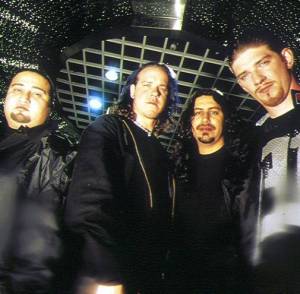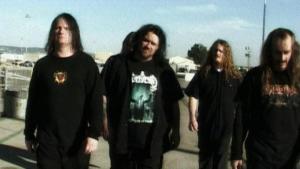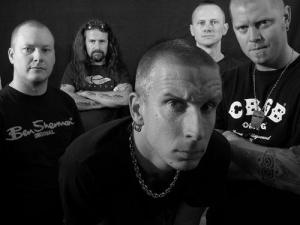Are you looking for the ultimate Heavy Metal soundtrack to spice up your Halloween party? Mr. Jon Schaffer and his henchmen can definitely help you with that.
 Tampa, Florida-based Power/Thrash Metal veterans Iced Earth might be one of the most underrated bands in the history of heavy music, and I believe they’re not bigger or more famous due to Mr. Jon Schaffer’s fickle temper, which has resulted in countless (and unstable) lineup changes in the history of the band, lowering any expectations a fan might have about their future. I personally don’t care that much about the mood of any musician, as long as this doesn’t negatively affect the overall quality of the music. Take a look at Dave Mustaine and Dani Filth, for example, and you’ll notice there are some changes in their music, but the core essence of Megadeth and Cradle of Filth is always there for the delight of their fans. Due to those constant changes you never know exactly what to expect from Iced Earth, as they sometimes deliver really bad material, but fortunately for all of us their 2001 album Horror Show showcases the Iced Earth we all want to listen to, sounding powerful, well-engendered and, above all, very creative and entertaining.
Tampa, Florida-based Power/Thrash Metal veterans Iced Earth might be one of the most underrated bands in the history of heavy music, and I believe they’re not bigger or more famous due to Mr. Jon Schaffer’s fickle temper, which has resulted in countless (and unstable) lineup changes in the history of the band, lowering any expectations a fan might have about their future. I personally don’t care that much about the mood of any musician, as long as this doesn’t negatively affect the overall quality of the music. Take a look at Dave Mustaine and Dani Filth, for example, and you’ll notice there are some changes in their music, but the core essence of Megadeth and Cradle of Filth is always there for the delight of their fans. Due to those constant changes you never know exactly what to expect from Iced Earth, as they sometimes deliver really bad material, but fortunately for all of us their 2001 album Horror Show showcases the Iced Earth we all want to listen to, sounding powerful, well-engendered and, above all, very creative and entertaining.
Horror Show is not just a traditional Heavy Metal album, also bringing a lot of the energy from Power Metal and some of the violence found in Thrash Metal, and that’s in my opinion the best “formula” Jon and his crew can offer us. Furthermore, it’s kind of a concept album focused on different horror stories, making it even more interesting for Heavy Metal fans that also enjoy reading a frightful book or going to the movies to see a good dosage of monsters and blood. For instance, all songs on the album are based on classic horror films, from werewolves to vampires and mummies, and many of the lyrics are lifted directly from the source material, proving that when Jon doesn’t let his personal issues interfere in his music, the final result is always fantastic. Add to all that some incredibly talented musicians like Matt Barlow on vocals, Larry Tarnowski on the lead guitar, Steve DiGiorgio (Testament, Death, Charred Walls of the Damned) on bass and Richard Christy (Death, Charred Walls of the Damned) on drums, and there you have the utmost recipe for awesomeness.
Wolf, the first track of the album inspired by The Wolf Man films, is an excellent heavy song to kick things off, showing why Jon is considered by many one of the best riff-makers in Heavy Metal. The speed of the song and its grinding riffs give it an amazing Thrash Metal touch, not to mention its chorus inspired by a poem that is recited in the 1941 film The Wolf Man, making any fan excited for the rest of the album. Then we have Damien, inspired by The Omen films, presenting outstanding lyrics that make a lot of sense if you have read the book or seen the movies like I’ve done (“When the Jews return to Zion / And a comet fills the sky / The Holy Roman Empire rises / And you and I must die”). As a matter of fact, the chorus was taken from the 1976 film The Omen, and the spoken section was adapted from a speech in its 1981 sequel, Omen III: The Final Conflict, just to give you a sense of how detailed this song is. Things get even better in Jack, inspired by the one and only Jack the Ripper, with Jon slashing our ears with his riffs in great “Ripper” fashion. Moreover, perhaps the funniest thing about this song is that Horror Show was the last studio album (apart from their album of cover songs called Tribute to the Gods, from 2002) Matt recorded before Tim “Ripper” Owens (The Ripper himself!) joined the band in 2003 and recorded The Glorious Burden in 2004, which is for me one of their best and most consistent albums of all.
The album continues with Ghost of Freedom, the only song that wasn’t inspired by any horror movie or character. It’s a very beautiful ballad and one of the top moments of the whole album, showing us a more “romantic” side of Jon and how good Matt’s voice can be even when he’s not screaming. The following three songs might not be masterpieces, but they surely keep the album at a high level of adrenaline and epicness. Im-Ho-Tep (Pharaoh’s Curse) (inspired by The Mummy), Jekyll & Hyde (inspired by The Strange Case of Dr. Jekyll and Mr. Hyde), and Dragon’s Child (inspired by Creature from the Black Lagoon) not only have amazing concepts, but the music itself is very pleasant and cohesive, embracing us all and pulling us deeper into the world of horror created by the band throughout the entire album.
 Frankenstein (“surprisingly” inspired by Frankenstein) is even better than those three tracks, raising your energy level and making you want to headbang like a crazy motherfucker, followed by the best song of Horror Show without a shadow of a doubt, the stunning Dracula (also “astoundingly” inspired by Dracula), a metal masterpiece that’s absolutely flawless from start to finish, presenting to the listener the duo Jon and Matt at the peak of their forms. This is an all-time fan favorite and a mandatory track in any of the band’s live setlists, also bringing to our avid ears ass-kicking lyrics (“Do you believe in love? / Do you believe in destiny? / True love may come only once in a thousand lifetimes…”). Lastly, we have The Phantom Opera Ghost, obviously inspired by The Phantom of the Opera, and despite all the additional elements and musicians it sounds too pretentious and doesn’t deliver what the fans are actually expecting.
Frankenstein (“surprisingly” inspired by Frankenstein) is even better than those three tracks, raising your energy level and making you want to headbang like a crazy motherfucker, followed by the best song of Horror Show without a shadow of a doubt, the stunning Dracula (also “astoundingly” inspired by Dracula), a metal masterpiece that’s absolutely flawless from start to finish, presenting to the listener the duo Jon and Matt at the peak of their forms. This is an all-time fan favorite and a mandatory track in any of the band’s live setlists, also bringing to our avid ears ass-kicking lyrics (“Do you believe in love? / Do you believe in destiny? / True love may come only once in a thousand lifetimes…”). Lastly, we have The Phantom Opera Ghost, obviously inspired by The Phantom of the Opera, and despite all the additional elements and musicians it sounds too pretentious and doesn’t deliver what the fans are actually expecting.
The limited edition has a bonus disc with two totally opposite moments: an incredible cover for Iron Maiden’s Transylvania, where Jon does what he does best with his guitar; and a tedious interview with him that lasts for over an hour. I guess there’s a one-disc version of Horror Show that includes Transylvania as a regular track, so if I were you that’s the one I would buy. And finally, one thing that Iced Earth have always delivered are stunning album arts. The band’s own mascot, Set Abominae, might not be part of the compositions this time, but he certainly makes the front cover of Horror Show designed by Danny Miki and Travis Smith darkly captivating. In a nutshell, Horror Show, which makes the already distant year of 2001 look like it just happened yesterday, is a mandatory choice for that Heavy Metal Halloween party you’re planning with your friends (as well as a good source of inspiration for your costumes), or maybe you can just dress up as Jon Schaffer and walk around your neighborhood playing some of the tracks from Horror Show on your guitar, how about that? We could even call this new Halloween tradition as “Trick or Thrash”.
Best moments of the album: Wolf, Damien, Ghost of Freedom, Dracula and Transylvania.
Worst moments of the album: The Phantom Opera Ghost.
Released in 2001 Century Media Records
Track listing
1. Wolf 5:20
2. Damien 9:12
3. Jack 4:14
4. Ghost of Freedom 5:12
5. Im-Ho-Tep (Pharaoh’s Curse) 4:45
6. Jekyll & Hyde 4:39
7. Dragon’s Child 4:21
8. Frankenstein 3:50
9. Dracula 5:54
10. The Phantom Opera Ghost 8:41
Limited Edition Disc Two
11. Transylvania (Iron Maiden cover) 4:30
12. Interview with Jon Schaffer (conducted by Sumit Chandra) 69:27
Band members
Matt Barlow – vocals
Jon Schaffer – guitar
Larry Tarnowski – lead guitar
Steve DiGiorgio – bass
Richard Christy – drums
Guest musicians
Yunhui Percifield – lead vocals on “The Phantom Opera Ghost” as “Christine”, backing vocals
Jim Morris – guitar solo on “Ghost of Freedom”, keys, backing vocals
Howard Helm – keys (pipe organ) on “The Phantom Opera Ghost”
Richie Wilkison, Rafaela Farias & Sam King – backing vocals





















